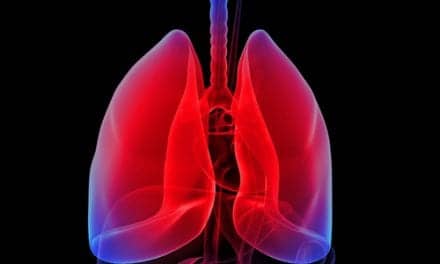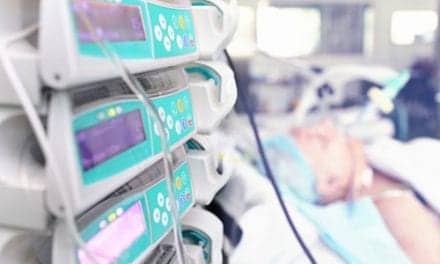Pulmonary hypertension (PH) was previously defined as a systolic pulmonary artery pressure greater than 40 mm Hg, corresponding to tricuspid regurgitation velocity on Doppler echocardiography of 3.0 to 3.5 m/sec.1 It is now defined as “a mean pulmonary artery pressure greater than 25 mmHg at rest or 30 mmHg with exercise, as measured by right heart catheterization.”2 Characterized by an increased pulmonary arterial pressure with secondary right ventricular failure, PH is a life-threatening condition that has a very poor prognosis if it is not treated.
Classification of PH
The disease was previously categorized as either idiopathic pulmonary arterial hypertension or secondary pulmonary hypertension, but the World Health Organization has attempted to provide clarity and organization to PH. This has led to the development of a new classification system.3 This five-step grouping system (Table 1) is based primarily on etiology. Of significance is the fact that patients in group one are considered to have pulmonary arterial hypertension (PAH), while those in the remaining four groups are said to have PH.
| Classification Group | Group Description | Group Inclusions |
|---|---|---|
| Group 1 PAH | Pulmonary arterial hypertension (PAH) | Idiopathic (IPAH) Familial (FPAH) Associated with (APAH)
|
| Group 2 PH | Pulmonary hypertension with left heart disease | Left-side atrial or ventricular heart disease Left-sided valvular heart disease |
| Group 3 PH | Pulmonary hypertension associated with disorders of the respiratory system and/or hypoxemia | Chronic obstructive pulmonary disease Interstitial lung disease Sleep-disordered breathing Alveolar hypoventilation disorders Chronic exposure to high altitude |
| Group 4 PH | Pulmonary hypertension caused by chronic thrombotic or embolic disease | Development abnormalities Thromboembolic obstruction of proximal pulmonary arteries Thromboembolic obstruction of distal pulmonary arteries Non-thrombotic pulmonary embolism (tumors, parasites, foreign material) |
| Group 5 PH | Miscellaneous | Sarcoidosis, pulmonary Langerhans cell histiocytosis, lymphangiomatosis, compression of pulmonary vessels by adenopathy, tumor, fibrosing mediastinitis, or other process |
Clinical features
Exertional dyspnea, extreme fatigue, and lethargy are symptoms that are common to most PH patients. These symptoms are primarily due to the inability to increase cardiac output with exertion.4 As the disease process progresses—including the development of right ventricular dysfunction—exertional chest pain, syncope, and edema of the extremities may develop. In some patients with PH resulting from severe COPD, edema may develop without the presence of right ventricular failure.5 Angina may develop due to stress on the ventricular wall and increased oxygen demand of the myocardium. It also may be the result of an enlarged pulmonary artery compressing the left main coronary artery. Increased heart sounds are a typical finding of patients with pulmonary hypertension.
Epidemiology
- <% ' not on devel, but on orange %>

- For news about a newly approved drug for PH, check out our July 2007 Regulation Update.
The actual prevalence of pulmonary hypertension in the general population is unknown. There are a number of studies looking at prevalence within specific populations, and the results are quite variable, ranging from as few as one or two people per million6 to as many as one per 2,000.7 It appears to be more prevalent in women and frequently results in death as a result of right ventricular failure within a few years following diagnosis. Whatever the numbers and demographics, PH is underestimated in developed and emerging nations alike, making additional studies critical.
Treatment
Early treatment of PH is strongly recommended because advanced disease may be refractory to therapy. There is no specific therapy for most types of Group 1 PAH, and many of these patients require advanced therapy. In the past several years, new pharmacologic agents that appear to have the potential to provide positive therapeutic applications for the treatment of PH have emerged. Given the prognosis of untreated PH, research in the use of these agents has been an area of tremendous interest.
Regardless of the causative factors, there are a number of therapies that should be considered for patients in all categories of PH8 (see Table 2).
| Therapy | Desired Outcome | Cautions |
|---|---|---|
| Diuretics | Diminish hepatic congestion and peripheral edema | Monitor for decreased cardiac output, arrhythmias |
| Oxygen Therapy | Treat/relieve hypoxemia | No long-term data available |
| Anticoagulation | Reduce chance of intrapulmonary thrombosis and thromboembolism | |
| Digoxin | Improve left ventricular ejection fraction | |
| Exercise | Increased six-minute walk test results, improved oxygen consumption |
Acute vasodilator testing is frequently performed in the cardiac catheterization center. Using right heart catheterization, a patient’s hemodynamic response to agents such as epoprostenol, adenosine, and inhaled nitric oxide is assessed. Since the inhaled nitric oxide is selective for the pulmonary vasculature, it is frequently better tolerated by the patient, as compared to intravenous epoprostenol or adenosine.
A significant development in the treatment of this disorder has involved the use of intravenous prostacyclin (prostaglandin I2, PGI2) and prostacyclin analogues. The infusion of prostacyclin has been shown in clinical trials to improve exercise tolerance and pulmonary hemodynamics.9
Vasoconstriction is a prominent feature of PH, believed to be due to impairment in the production of the vasodilators prostacyclin and nitric oxide in the pulmonary vascular endothelium. This provides a possible rationale for the use of vasodilators to treat this disorder. Nitric oxide, epoprostenol (prostacyclin), and adenosine are short-acting, potent, and titratable vasodilators that may be used to evaluate an acute response to therapy.1 Intravenous epoprostenol or adenosine generally produces pulmonary vasodilatory effects similar to those of inhaled nitric oxide.10 It should be noted that the continuous infusion of epoprostenol through a central venous catheter is costly, averaging in the vicinity of $60,000 per year. The high cost, combined with its undesirable side effects, points to the need for additional therapy options.
Inhaled nitric oxide, a selective pulmonary vasodilator, may demonstrate beneficial effects in diseases characterized by pulmonary hypertension and hypoxemia, including persistent pulmonary hypertension of the newborn, PH, and acute respiratory distress syndrome. The cost of nitric oxide administration is currently in the range of up to $3,000 per day, with a cap of $12,000. It should be noted, however, that evidence regarding the effectiveness of inhaled nitric oxide in the treatment of pulmonary hypertension in the adult population is lacking in terms of improving mortality. Some studies have demonstrated an improvement in gas exchange, with no change in patient outcome.11
In some clinical conditions such as lung fibrosis with accompanying pulmonary hypertension, the administration of systemic vasodilators may lead to troubling side effects. Severe systemic hypotension, in the absence of adequate cardiac output, and worsening of ventilation/perfusion mismatching and shunting have been shown to occur in some patient populations.12,13
There has been some investigation into the use of oral prostacyclin, but this has been limited because of poor bioavailability. Several small clinical studies have examined stable prostacyclin analogues, such as beraprost. Administered orally, beraprost was found to acutely reduce pulmonary artery pressure.14 In a more recent study, beraprost was observed to result in an increased exercise tolerance, evaluated using the 6-minute walk test.15
Calcium-channel blockers such as nifedipine and diltiazem are popular for long-term therapy, although significantly larger doses than those typically used for treating systemic hypertension and coronary artery disease may be necessary. An alternative calcium-channel blocker, amlodipine, has more selective vasodilator properties and has been used on patients who cannot tolerate the side effects produced by other agents. Table 3 shows the most commonly used vasodilators for treating PH.
| Drug | Route | Dose Range | Half-Life |
|---|---|---|---|
| Epoprostenol | Intravenous | 2-20 ng/kg/min | 3-5 min |
| Adenosine | Intravenous | 50-200 ug/kg/min | 5-10 sec |
| Nitric oxide | Inhaled | 5-80 ppm | 15-30 sec |
| Nifedipine | Oral | 30-240 mg/day | 2-5 hr |
| Diltiazem | Oral | 120-900 mg/day | 2-4.5 hr |
The oral and intravenous administration of sildenafil, a cyclic-guanosine-monophosphate phosphodiesterase inhibitor, has been examined and shown to enhance and prolong the vasodilatory effects of inhaled nitric oxide.16,17 A study comparing the effects of inhaled iloprost to oral sildenafil in pulmonary hypertension found that iloprost caused a greater reduction in pulmonary artery pressure, while the effects of sildenafil, having a smaller effect on pulmonary artery pressure, produced a much longer duration of action. The combined effects of inhaled iloprost, which is a prostacyclin analogue, with oral sildenafil resulted in a further reduction in PAP and an increase in cardiac output without affecting the heart rate or systemic blood pressure significantly.18 Another inhaled drug that has shown potential is aerosolized epoprostenol.
Inhaled epoprostenol has demonstrated the ability to produce selective pulmonary vasodilatory effects that are similar to those of inhaled nitric oxide, without the unpopular side effects experienced with systemic delivery of the drug.6 In one study, a reduction in mean pulmonary artery pressure of 10% to 20% was observed following a single inhalation of iloprost.19,20
Medical treatment for PH may include anticoagulation with warfarin, considered by some as the drug of choice; calcium channel blockers; and continuous intravenous or aerosolized prostacyclin analogues.21 Although these treatments may improve survival rates, lung or heart-lung transplantation may provide the most definitive treatment of the disease. Other therapy that is currently under investigation includes the use of phosphodiesterase inhibitors and endothelin receptor antagonists.22 In a study of 32 patients with PH,23 patients receiving the endothelin receptor antagonist, bosentan, were compared to those receiving placebo drugs. The results demonstrated an increased exercise capacity and improved blood circulation for those receiving bosentan. Pulmonary vascular resistance, a primary characteristic of pulmonary hypertension, also was significantly reduced in the bosentan patients. In addition, the average pulmonary artery pressure, pulmonary capillary wedge pressure, and right-atrial pressure were all reduced in the bosentan group.23
With the identification of the genes associated with cases of PH, the pathogenesis of this potentially fatal disease is becoming better understood. Further research is necessary to focus on the development of therapeutic interventions to improve the outcome of those patients with PH. The challenge for future research activities is to identify an effective, technically feasible, and less costly method of treating individuals with pulmonary hypertension.
Treating patients with pulmonary hypertension can be a challenge, even for the more experienced medical teams. Giving consideration to the referral of these patients to a specialized center should be encouraged. Improvements associated with the treatment of this disease will rely upon additional, well-controlled clinical trials.
Paul Nuccio, RRT, FAARC, is director of respiratory care, Brigham and Women’s Hospital, Boston. For further information, contact [email protected].
References
- Rich S. Executive summary from the World Symposium on Primary Pulmonary Hypertension, Evian, France, September 6-10, 1998, co-sponsored by The World Health Organization.
- Barst RJ, McGoon M, Torbicki A, et al. Diagnosis and differential assessment of pulmonary arterial hypertension. J Am Coll Cardiol. 2004;43:40S.
- Simonneau G, Galie N, Rubin LJ, et al. Clinical classification of pulmonary hypertension. J Am Coll Cardiol. 2004;43:5S.
- Runo JR, Loyd JE. Primary pulmonary hypertension. Lancet. 2003;361:1533.
- Weitzenblum E, Apprill M, Oswald M, et al. Pulmonary hemodynamics in patients with chronic obstructive pulmonary disease before and during an episode of peripheral edema. Chest. 1994;105:1377.
- Rubin LJ. Primary pulmonary hypertension. N Engl J Med. 1997;336:111.
- Humbert M. The burden of pulmonary hypertension. Eur Respir J. 2007;30:1-2.
- Hopkins W, Rubin LF. Treatment of pulmonary hypertension. In: Rose BD, ed. UpToDate. Waltham, Mass: UpToDate; 2007.
- Barst RJ, Rubin LJ, Long WA, et al. A comparison of continuous intravenous epoprostenol (prostacyclin) with conventional therapy for primary pulmonary hypertension. N Engl J Med. 1996;334:296-301.
- Sitbon O, Brenot F, Denjean A, et al. Inhaled nitric oxide as a screening vasodilator agent in primary pulmonary hypertension: a dose-response study and comparison with prostacyclin. Am J Respir Crit Care Med. 1995;151:384-9.
- Troncy E, Collet JP, Shapiro S, et al. Inhaled nitric oxide in acute respiratory distress syndrome. Am J Respir Crit Care Med. 1998;157:1483-8.
- Olschewski H, Ghofrani HA, Walmrath D, et al. Inhaled prostacyclin and iloprost in severe pulmonary hypertension secondary to lung fibrosis. Am J Respir Crit Care Med. 1999;160:600-7.
- Augusti AGN, Rodriguez-Robin R. Effect of pulmonary hypertension on gas exchange. Eur Respir J. 1993;6:1371-1377.
- Saji T, Ozawa Y, Ishikita T, et al. Short-term hemodynamic effect of a new oral PGI2 analogue, beraprost, in primary and secondary pulmonary hypertension. Am J Cardiol. 1996;78:244-7.
- Nagaya N, Uematsu M, Okano Y, et al. Effect of orally active prostacyclin analogue on survival of outpatients with primary pulmonary hypertension. J Am Coll Cardiol. 1999;34:1188-92.
- Zhao L, Mason NA, Morrell NW, et al. Sildenafil inhibits hypoxia-induced pulmonary hypertension. Circulation. 2001;104:424.
- Shekerdemian LS, Ravn HB, Penny DJ. Intravenous sildenafil lowers pulmonary vascular resistance in a model of neonatal pulmonary hypertension. Am J Respir Crit Care Med. 2002;165:1098-1102.
- Wilkens H, Guth A, Konig J, et al. Effect of inhaled iloprost plus oral sildenafil in patients with primary pulmonary hypertension. Circulation. 2001;104:1218-22.
- Hoeper MM, Olschewski H, Ghofrani HA, et al. A comparison of the acute hemodynamic effects of inhaled nitric oxide and aerosolized iloprost in primary pulmonary hypertension. German PPH study group. J Am Coll Cardiol. 2000;35:176-82.
- Galie N, Torbicki A, Barst R, et al. Guidelines on diagnosis and treatment of pulmonary arterial hypertension. The Task Force on Diagnosis and Treatment of Pulmonary Arterial Hypertension of the European Society of Cardiology. Eur Heart J. 2004;24:2243-78.
- Gaine SP, Rubin LJ. Primary pulmonary hypertension. Lancet. 1998;352:719-25.
- Newman JH, Lane KB. Hypertensive pulmonary vascular disease. Am J Respir Crit Care Med. 2000;162:2020-21.
- Channick RN, Simonneau G, Sitbon O, et al. Effects of the dual endothelin-receptor antagonist bosentan in patients with pulmonary hypertension: a randomized placebo-controlled study. Lancet. 2001;358:1119-23.









